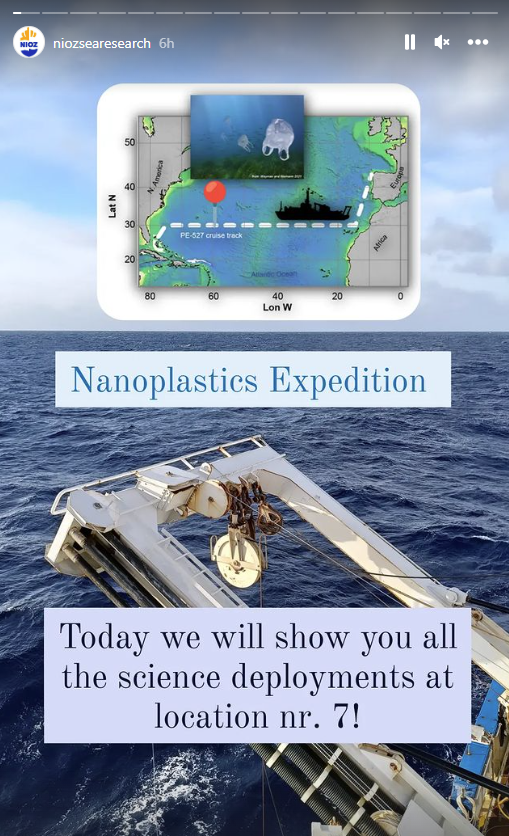20 December 2023
At the entrance to the Caribbean Sea - By Helge Niemann Chief Scientist during cruise PE-527
Not long and we will be back on land. The pilot for Nassau Harbour just came on board to navigate our trusted vessel through a canal between giant cruise ships and a small island. Though everyone is itching to explore Nassau, to stretch out, it feels a bit strange to leave this ship so soon. Pelagia has been our home for the last 4 weeks, crossing the Atlantic ocean along 30°N. We spent more than 160 hours on station, launching a series of instruments: CTD, nets, boxcorer, free falling profilers… watching the first data coming back from cameras and sensors. We fell into the rhythm of the boat, the daily routine of changing watches and meal times – the metronome structuring the day of a research vessel.
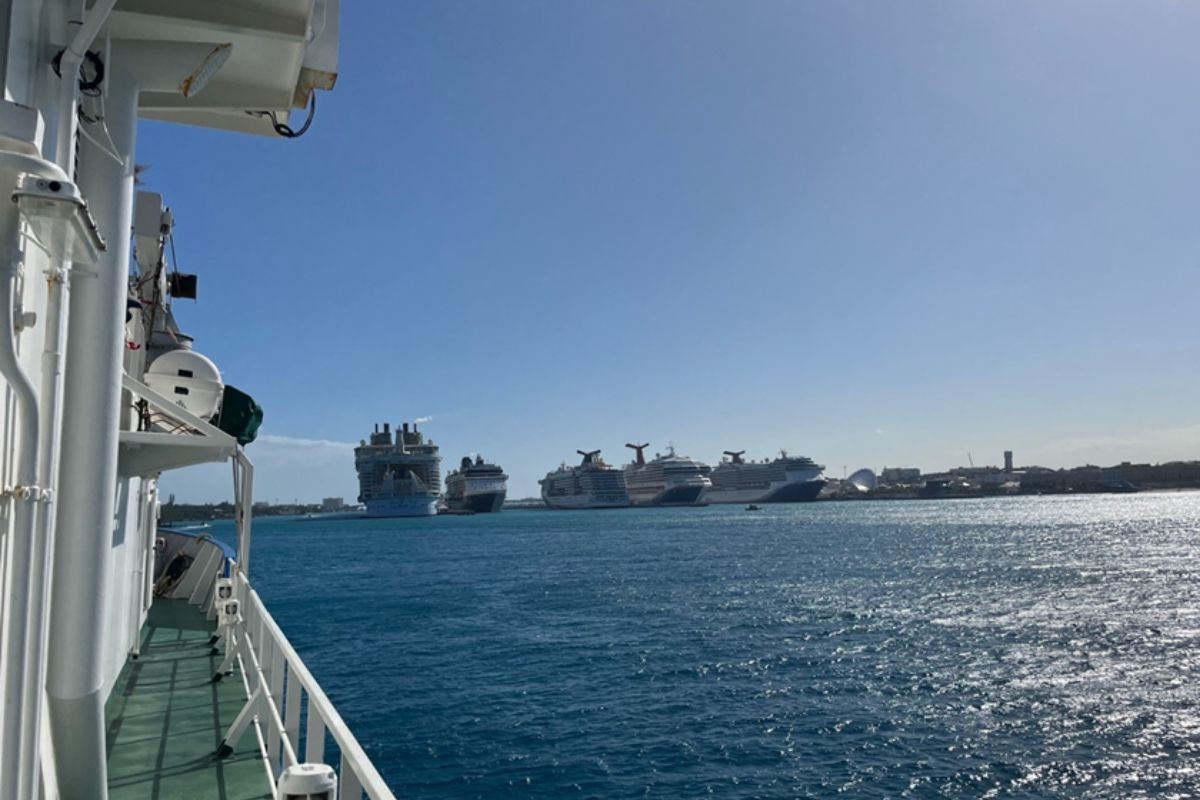
It feels like yesterday when we boarded the ship in Vigo Spain, but almost 4500 nmi are behind us, an entire ocean. And one can see that. Those that were at sea for the first time, walked a bit with wobbly legs when the first waves rocketed us, back then still in Spanish waters. Now everyone has sea legs. Our equipment is packed up for the most part, stored in boxes and containers, ready to be shifted into the cargo hold of Pelagia or getting an air lift back to our home laboratories. It was a fantastic cruise, a nice atmosphere, among the scientists but also with Pelagia’s crew. Smaller and bigger technical problems have been solved and we were able to get a wealth of samples and data. I can’t wait to see what we found. Are there nanoplastics in the Atlantic? And if so, where? Only at the surface or also in the deep sea? What will we find in our samples? But the answer to this must wait. It’s good to relax now, to get out of the 24/7 working mode, to not plan the next station, discussing data or instrumental problems. We will spend one day in Nassau together an then will part into the four corners of the wind, after all we’re an international team and Christmas is at the doorstep! One goes to Mexico, another one to Japan, one to the US, and some back to the Netherlands.
After meeting friends and family, we will meet again in January. Some in person, others will connect remotely. The group will be bigger, not only comprised of the scientists that were on board but also others for whom we took samples and conducted measurements. We will discuss what we found, and what we will do next.
18 December 2023
By Pepien Rubbens, Masterstudent at Utrecht University, intern at NIOZ
A few days ago, we got the news that a subtropical storm might be interfering with our plans during the last week of this cruise. We have had swells in the past weeks but nothing like what is coming up. While surfing the waves leading us westwards across the Atlantic Ocean, we spotted dolphins and countless flying fish. Although we have had many sunny days out here, the sea state can change quickly showcasing the unpredictability of being out at sea. However, despite the upcoming storm, the atmosphere is great on board and has been great during the whole crossing. The Pelagia Christmas tree has been decorated and we have movie nights if the work program allows that. I feel really lucky that I get to experience this crossing as a master student.
Because this expedition's main focus is nanoplastics, my master thesis project fits right in as I am working on microbial plastic degradation. Every day, huge amounts of plastics enter the ocean and it is not clear what exactly happens with that plastics. Does it all stay in the ocean, or is some of it degraded? It has been shown that some marine microorganisms can degrade plastics, but there are still so many unknown factors about this process, for example: how fast does this happen, and what plastic types are more likely to be degraded? At the sea surface, plastics are also affected by solar UV light. This makes plastic brittle and more ‘tasty’ for microbes to feed on. To study this process, I use special plastics that are labeled. These plastics are added to the seawater samples that I collected during the cruise. When the microbes degrade this plastic, the CO2 they ‘exhale’ will also be labeled. In this way, I can calculate the amount of plastic that the microbes can degrade over time.
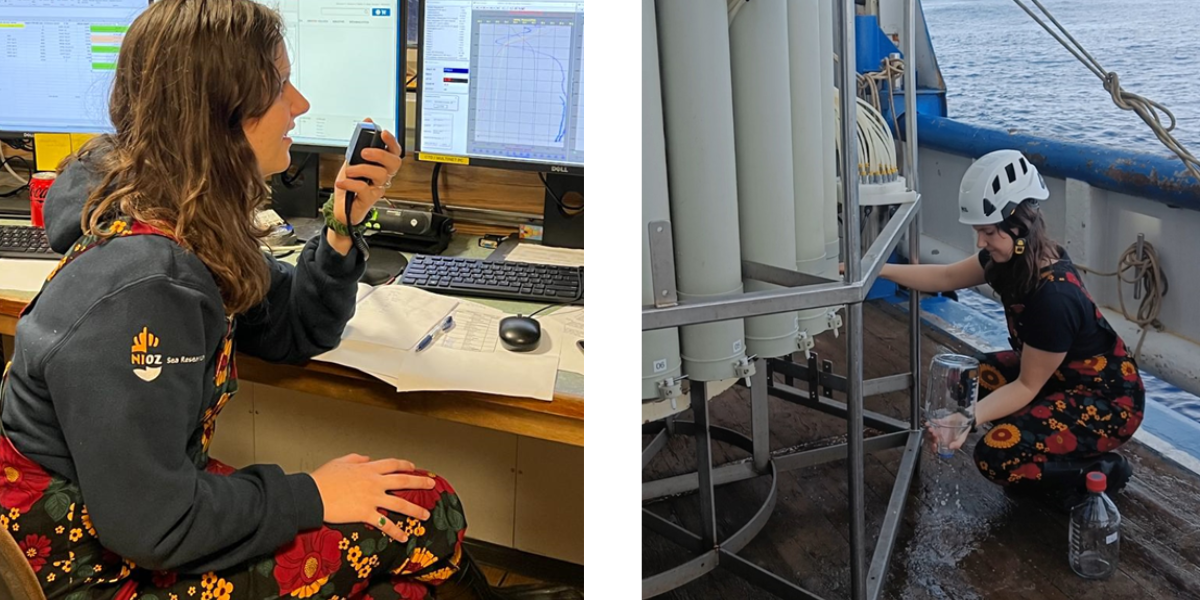
Being on board this research vessel has been very inspiring because all researchers work tightly together on board. The exposure to many research projects gives me the chance to expand my knowledge in the field of marine sciences in general and plastic research specifically, by observing and helping out where I can. A scientific presentation is given every time we are in transit to a new research location by one of my fellow researchers. So, we are up to date about the current and/or previous research of the science team enabling us to brainstorm about scientific problems and to learn from each other even more.
Despite the upcoming storm, I am looking forward to the last few days of the cruise. Also, as we see the sea surface temperature increasing as we are travelling more southwards, I am excited to go swimming in the ocean that has been surrounding us for the past four weeks once we arrive in Nassau. After being on two research cruises back to back, many samples are waiting for me at NIOZ. I am extremely curious what the outcome of my experiments on board will be. In January I will start generating data that can hopefully add a piece to the puzzle of figuring out what the fate of plastic is once it enters the marine environment.
17 December 2023
By Julia Schnetzer, PostDoc at AWI Bremerhaven
RV Pelagia, the name, already foreshadows what lays ahead of us. To describe the waters of the open sea, scientist use the word pelagic, which derives from the ancient Greek word pélagos and means exactly that, „open sea“. And that’s where we have been, now already, for a couple of days. Only water surrounding us, water as far as the eyes can see, and every day it is a bit different in color, in movement, in sound and in the secrets it holds for us. Every couple of days we will make a stop and sample all different layers the pelagial has to offer, looking for plastics but also to get a glimpse of the life which is out there in this vast ocean desert. The Epipelagic, the sunshine zone where the light of the sun reaches up to 200 meters and makes photosynthesis possible, is the one that intrigues me the most.

Tiny microalgae build the base for a community of zooplankton and other creatures. With our nets we collect microplastics from this layer and also get to meet the organisms which habitat is polluted by it. We have the pleasure to have Erik on board with us, who is quite familiar with this fauna and is happy sharing his knowledge and giving us a closer look upon those tiny creatures with the microscope he brought along. His interest lies in understanding how plastic is affecting those tiny creatures. Are they troubled by it? Or do they use it for their advantage, as a new home or hiding place?
Every time we pull the net out, I get excited to see what we have caught this time. Bright blue Copepods, super tiny jellyfish, silver shimmering fish larvae, jumping crustaceans or almost invisible skeleton shrimps. And of course, last but not least the majestic blue ocean dragon, a petite nudibranch which floats the pelagic ocean on its spread-out wings and hunts for jellyfish. „But don’t be fooled by its beauty and touch it, 'cause they can give you a nasty sting.“ Erik warns me. The catch never fails to amaze me and to meet organisms I have never heard of before.
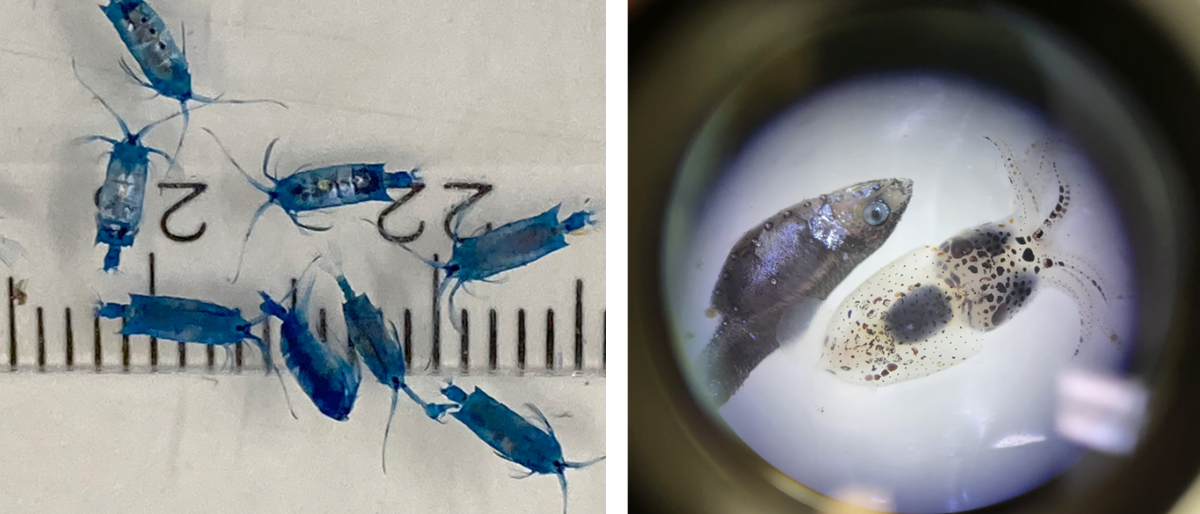
I was especially amazed to see Halobates for the first time in my life. Those are fascinating animals which most people are not even aware of their existence. But how should they, most people do not sail around the ocean with plankton nets, and that’s probably the only way you can get to see them. Halobates, also known as sea skaters, -you may know their relatives running over lake or pond surfaces- are one of the very rare insects that live exclusively in marine systems, and only 5 species are known so far, which live their entire life on the open ocean. Making them the only offshore insects we know of!
These small insects are perfectly built so they can glide on their long legs over the ocean surface despite wind and waves, and catch plankton with their tiny claws. Their body is covered with a film of fine hair which traps air bubbles and keeps them a float, if they get dragged down by a splash. I can see these hairs shine in a silver hue, while I watch them run around in our buckets. They are fast, it’s amazing to watch them and to wonder how they can survive the rough world out there. Nature and how life finds its ways is fascinating. „Pack them up!“ Erik tells me and brings me right back to reality. No time to wonder about natures art. We have to get back in the lab. We have to keep on sampling. Our to-do list is long, we have to make the most of the time we have out here. But I will keep on wondering, being amazed and fascinated every free second I have on this wonderful journey.
Dr. Julia Schnetzer works with Dr. Mar Fernández-Méndez at the Alfred Wegener Institute, who is collaborating with the Amaral-Zettler research group at NIOZ to study the brown macroalgae Sargassum.
14 December 2023
By Helen Wolter, the Ocean Cleanup
How to Spend your Birthday at Sea
The day will begin like any other – we will be ‘gently’ tossed out of our bunks as the Pelagia pitches and rolls her way through the North Atlantic, a familiar motion that is constant but not consistent enough to grow completely accustomed to. Bleary-eyed, we’ll make our way into the mess hall for breakfast, where Enno, our cook, will have prepared something shockingly fresh considering it’s the beginning of our fourth week at sea. The sound of the coffee machine churning out the watchstanders’ fuel will be accompanied by sleepy goedemorgen’s and gentle discussion of last night’s dreams or action movie. Peter and I will head to the monkey deck, above the bridge, where we fasten our vessel cameras, logging the sea surface during every hour of daylight on this cruise, scanning the ocean for detectable plastic debris. With anyone brave enough to join us, we will conduct our sun salutations, a non-negotiable morning and evening ritual that has kept the tempestuous seas at bay thus far. We’ll stop by the bridge for a coffee. An hour will pass, maybe two. These small routines are the cornerstone of preserving sanity when your whole world has been compressed into 66 meters for four weeks.

And yet, on this day, one thing will be remarkably different. Will we, after weeks of beating our way West, have reached the eastern boundary of the North Atlantic Garbage Patch? Watchful eyes excitedly call out observations of a lone ghost net or buoy that is seen from the ship, though there’s been only minor increases in frequency of these calls as the days go on. Or perhaps Jonas, our stowaway red-footed booby, will have taken flight off the foremast in the direction of Bermuda, having used our ship as a tool for increasing his flying fish consumption, chasing them as they soar through the air in our wake. One difference will stand out among the rest, a small voice in the back of my head will remind me that, once again, a whole year has passed since the last time it was December 14th.
I’ve had a few birthdays offshore, each embroiled in scientific exploration as we push aside land priorities in favor of what is hiding in our big blue oceans. It’s a chance to be humbled by the magnitude and significance of the seas we study, since even Jonas could tell me that the stormy Atlantic won’t rest just because I’ve survived another year on this planet. It’s a chance to look inward, reflect on the community that so easily forms after mere days at sea, as a group of complete strangers learns to live so remarkably harmoniously as we spend most waking moments of the trip together, learning to enjoy, or tolerate, each other’s idiosyncrasies. And a chance to anticipate what the future may hold: what will await us back onshore, what will change as another year passes, how will our knowledge of this ocean change with the measurements we are taking today?
With these thoughts, I will head to the back deck, ready to deploy our plastic-sampling nets, trying my best to keep conditions constant as the environment around me that is in continuous motion.
11 December 2023
By Niek Kusters, PhD student in Physical Oceanography at Ocean Systems, NIOZ
This last week, the winds gained in strength and we got to endure a mighty swell. The conditions become more tricky to navigate, but luckily not so much that we cannot do our science anymore. Nevertheless, the temperatures are still nice and when the sun comes out, it can even be hot! During this trip, we have a lot of scientists on board with different expertise and backgrounds. I find it very interesting to see and hear about what kind of research everyone does, about the instruments they brought for that and the samples they take with it. It sheds a light on what for an amazing place the ocean is, and how much there is still to discover!
My PhD research focusses on Ocean Mixing. Mixing in the ocean consists of many different processes, that act on a large range of different scales, both in space and in time. This makes that it is difficult to measure. Where my PhD research focusses on both the large scale and small-scale mixing in general, during this expedition we are more interested in the small-scale mixing. We want to see if it plays a role in bringing the plastics that we find to the deep sea. Even though this small-scale mixing is tricky to measure, as it can reach low values in the ocean interior, it can be measured. For that we brought a special instrument with us, a so-called Vertical Microstructure Profiler (VMP).
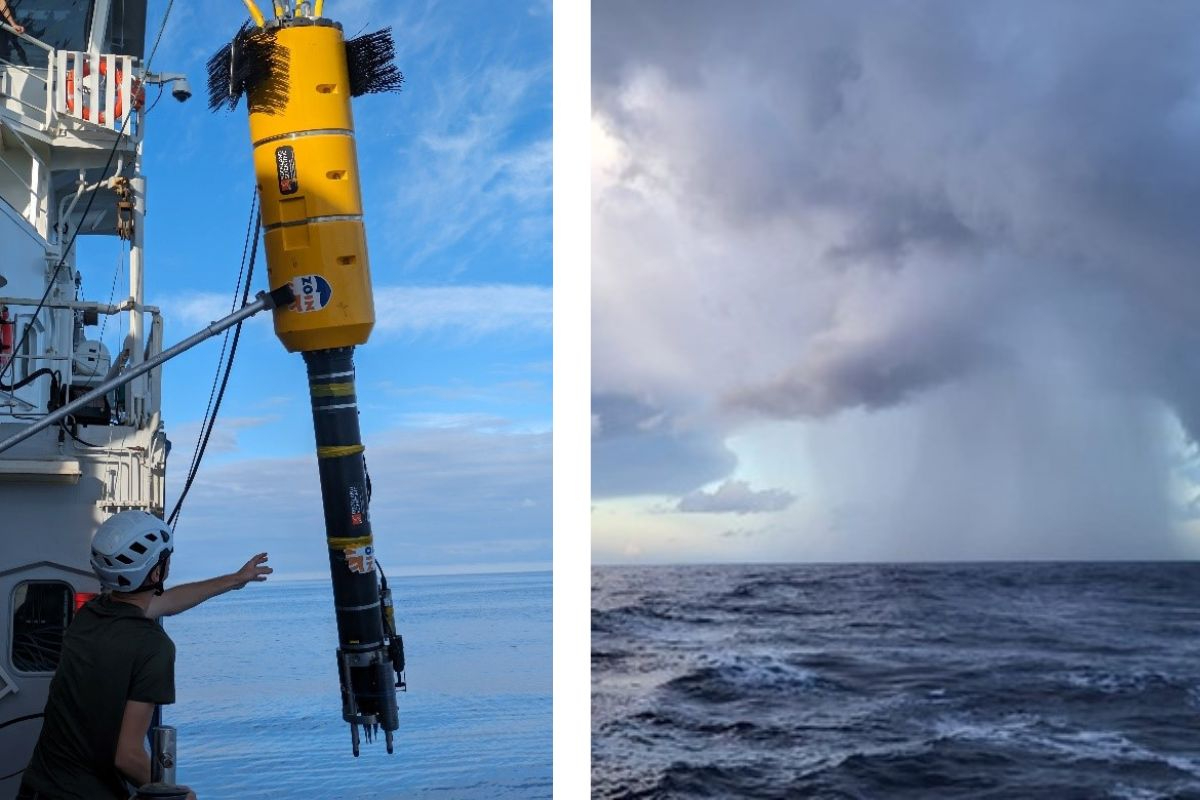
The VMP, or “The Dart” as most people on board like to call it, can measure the small-scale turbulence in the water by measuring the small-scale velocity fluctuations and temperature variations, to millimeter or centimeter resolution. Later, we can calculate from these measurements the strength of the mixing. Roughly said, this turbulence is stronger near the surface where winds and waves play. And closer to the bottom, especially over rough topography, the turbulence is more intense. But away from all boundaries, bottom and surface, the turbulence in the ocean interior can also reach very low values. Hence the VMP is a very sensitive instrument, so it is able to also measure these low levels of turbulence. It brings an extra challenge, to have such a delicate instrument that needs to be handled with care, in an environment that can be characterized at times as nothing less than rough. With the winds, waves and other heavy instruments being handled on deck as well. But every time it comes back to the surface, it is spotted and safely brought back on board, it is great to see that all sensors performed well and we got another new profile of measurements.
The past few days we sailed along the Atlantis Fracture Zone across the Mid-Atlantic Ridge. With that, we sailed into the western part of the northern Atlantic Ocean and we left the half-way point behind us. We have still have a week and a half to take measurements and samples, and above all, enjoy this amazing experience of sailing across the Atlantic!
7 December 2023
By Nemat Omidikia (PostDoc at NIOZ and Utrecht University)
We started this cruise with numerous questions around nanoplastics, which are of relevance for the environment and society alike. In anticipation of this expedition, we spent months preparing ourselves for the task at hand. Today, we stand prepared to collect substantial evidence that will unravel answers to the questions that have fueled our curiosity. Reaching down to 5.000 meters, our sampling efforts represent a crucial phase in our search to understand nanoplastic dynamics in the open ocean.
In the vast expanse of the North Atlantic, the Pelagia navigates the undulating waves, parting them with determination. Our journey extends beyond the radiant daylight hours, persisting into the veiled tapestry of the night. Hand in hand, our spirits unified, and we share a common purpose—a shared mission to unravel the answers to the questions that have ignited our curiosity.
As a postdoctoral researcher, the Nanoplastic cruise has proven to be a truly remarkable journey. The collaboration with both the scientific team and the Pelagia crew has added an enriching dimension to this experience. There was a moment of disappointment when the air sampler ceased operation due to a motor fault. However, the efficiency of the engineering team resolved the issue.
Even though we've been on this cruise for several days now, the Atlantic seems to have grown more turbulent, with waves crashing against the Pelagia. I've been battling seasickness for the past couple of days. Yet, our determination remains unwavering as we steadfastly gaze upon the clouds, seeking solace and, perhaps, receiving the answers we've been tirelessly pursuing.

4 December 2023
By Claudio Pierard (PhD student in Ocean Physics, modelling currents and other parameters to understand dynamics in the ocean at IMAU, UU)
As a PhD student in physical oceanography, most of my days are spent in front of my computer, doing computer simulations to study how the ocean transports plastic. So far, I have no experience in field campaigns. This oceanographic expedition marks my initiation into scientific expeditions, where I’ll be gauging the physical properties of currents responsible transporting plastic across the ocean.
Embarking on this expedition is a chance to explore uncharted waters, both literally and metaphorically. What struck me halfway through my PhD is the scarcity of measurements of microplastics suspended in the deeper layers of the ocean and the lack of measurements of nanoplastics. That is why this expedition is so interesting and valuable. It will shed light into the state of the ocean regarding plastic pollution, with a special focus on nanoplastics, the smallest plastic particles.

Heading west towards North America in a ship puts the speed of modern travel into perspective. The ocean is massive! Distances that appear short on maps take several days to reach by ship. And our progress is limited by the weather conditions, which have been good to us so far. Being out at sea was a rollercoaster of emotions for me. Before setting sail, I asked for advice to more seasoned colleagues and friends. Their advice painted a mosaic of expectations—fear of seasickness, excitement for adventure, distance from loved ones—which so far, I have experience at some degree. Yet, as we progress in our planned route, I have realized how exciting it is to be here, learning from the fellow scientists and the crew of the Pelagia.
On transit days, the occasional encounter with fishing floats and plastic items reminds us of our mission. Each piece bobbing in the waves came from somewhere and holds a story. Trying to decipher thar story is something that I will be working on once I return home.
There still a long way to go and I’m looking forward for what is to come, and I'm already itching to dive deeper into the data collected which is a valuable piece of information in the ocean plastic puzzle.
30 November 2023
By Peter Puskic, The Ocean Cleanup
It’s my first time in the Atlantic and I am excited. There is pretty powerful feeling when being at sea, on calm days you enjoy the sunlight and the seemingly endless expanse of sea. You watch the sun rise and set over the ocean, following the moon and sun on their daily celestial dance. On rough, big swell days you are reminded of the power of nature. When the storm clouds roll through you feel the ship shake as waves break at the bow and share excited grins with your crew mates as you grip the railings and feel the power of the wind.

When the weather is like it is today, rough and stormy, I like to stare at the sea and search for my favourite ocean creatures, seabirds. Particularly I look for Procellariforms, shearwaters and petrels. Along with sighting new seabird species being aboard the RV Pelagia has also been a great opportunity for me to practice my Dutch. I have learned that the Dutch word for shearwaters is pijlstormvogels. It is unsurprising that both the Latin and the Dutch names describe these creatures as storm birds because it is in these conditions that they thrive the most, riding on the wind and shearing the water’s surface. They surf on the wind and the waves. These incredible birds and often migrate long distances between breeding and foraging. They are long lived animals, some live to be as old as 50 years old. They've seen the many changes in our ocean, and they have tales to tell.

Our ocean is changing rapidly, climatic changes, plastics and other pollutants are creating a new suit of threats for the stormbirds to face. In fact, shearwaters here in the Atlantic, like the Cory’s Shearwater and Great Shearwater eat some of the highest quantities of plastic of any other marine organism. This is because seabirds search the vast blue desert of the ocean looking for food. Plastics often “bio-foul” meaning they develop a layer of marine bacteria that raft on the plastics surface. This is a problem as storm birds use their highly developed nose to smell their way around the ocean and they're often deceived by bio-fouled plastics which create the same chemical signatures as food. Plastics may harm seabirds changing their microbiome composition, impacting their growth or by leading to starvation and even death.

Prior to my current role as a marine scientist for The Ocean Cleanup, my PhD studies had explored the physical impacts of plastic ingestion in seabirds. Here, while working with the NOIZ scientists aboard the Pelagia I am seeing the complete the life cycle of plastics from the oceans to the wildlife. In fact, during our visual surveys and surface water trawls I have seen more plastics than I had expected. I am remined that even out here, in the middle of the Atlantic Ocean, where only seabirds fly, there is no escape from the impacts of the human world and that our reach is far and wide.

23 November 2023, Vigo (Spain)
Sailing along the old Tradewind Route - the search of the Big small by Helge Niemann, Chief Scientist during cruise PE-527 with RV Pelagia.
I escaped the grey drizzle, the classical November rain, left my normal life and my everyday work behind me when I walked over the gangway, stepping aboard RV Pelagia - the flag ship of the Dutch research fleet. It is not the first time onboard this trusted old lady, but it is something special to cross the entire Atlantic. An echo of long past times comes up: busy quays with flying merchants, tall masts of big sailing ships ready to sail out with the tide, to cross the Atlantic Ocean to new horizons in the Caribbean or North America. But we are neither merchants, slave traders or emigrants. Perhaps one could call us adventurers. But other than an adventurer in a fantasy role game, our quest is not to find richness in a virtual reality. We are scientists and set out to cross the Atlantic to investigate nanoplastics. Something that, although being so very minuscule, could be a lot.
The news about the pollution of our oceans with plastic waste and the negative consequences for marine life are omnipresent. This avalanche comes from the continents and plastic is also littered from ships. Bigger pieces swimming at the ocean surface drift with currents and are pulped into ever smaller pieces as a result of the scorching sun’s UV light and the smashing force of waves. In this way, bigger pieces become smaller; macro plastics become microplastics until...

...Until what? Mostly from laboratory experiments, we know that at least some parts of the bigger macro and microplastics are broken into particles that are smaller than 1 thousands of a millimetre. That is at least 15 times smaller than the thickness of a thin human hair - and thus invisible to the bare eye. These tiny plastic particles are called nanoplastics. And they behave rather oddly. Plastic usually floats or sinks. For example, poly ethylene (PE), the most commonly produced plastic type, floats, while polyethylene terephthalate – PET, sinks. But nanoplastics neither float nor sink regardless of whether they are PE, PET or another type of plastic. Nanoplastics behave like milk in coffee: the milk’s white fat droplets get equally distributed, neither swimming as cream at the surface nor sinking to the bottom of the cup. Almost all marine life might thus be in contact with nanoplastics. But we don’t know how much nanoplastic is out there in the ocean. Is it so far only at the ocean surface where much of the macro and micro plastic has been found? Is it already in the deep sea? What is the fate of nanoplastics in the ocean? These are just a few of the many questions that we try to answer during this ocean crossing expeditions.
For the next weeks, we will breathe science, take samples, measure, discuss and start experiments – during expedition PE-527 across the Atlantic Ocean.
